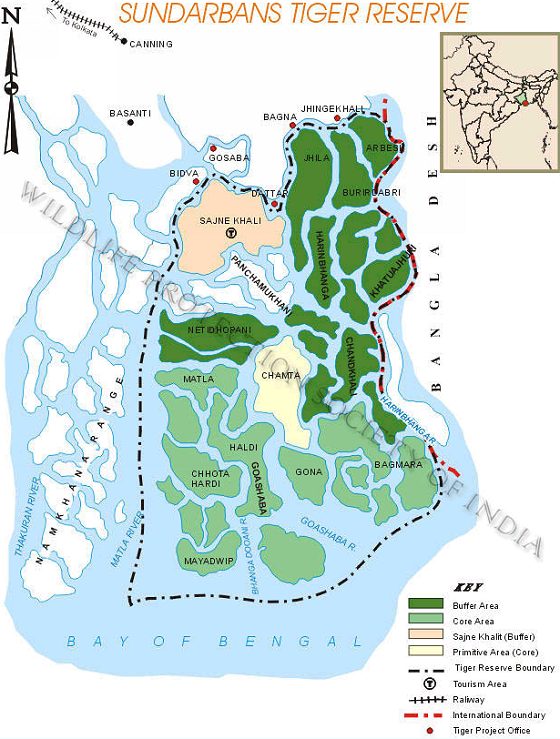Tiger Reserves
| |
|
|

|
|
Sundarban
Tiger Reserve
|
|
State
|
West
Bengal
|
History
|
|
Altitude
(above M.S.L.)
|
5.8
- 6.1 m.
|
Sundarban
Tiger Reserve was created in 1973, and constituted
as a Reserve Forest in 1978. The current
core area was established as a National
Park in 1984. Recognising the region and
its unique biodiversity, the National Park
was listed as a World Heritage Site in 1985.
The entire Sundarban area was declared a
Biosphere Reserve four years later.
|
|
Area
|
Total
|
2585
km²
|
|
Core
|
1330
km²
|
|
Buffer
|
1255
km²
|
|
Flora
and Fauna
|
|
Sundarban
is part of a vast estuary in the Bay of
Bengal. The mangrove forests are the only
tiger habitat of its kind. The trees and
other wildlife have adapted to the estuarine
conditions of high salinity, lack of soil,
erosion and daily overflow by high tides.
An estimated 270 tigers are found here.
|
|
Temperature
|
20°C - 34°C
|
|
Rainfall
(per annum)
|
1920 mm
|
|
Fauna
|
|
Tiger,
fishing cat, spotted deer, wild boar, gangetic
dolphin, water monitor, estuarian crocodile,
river terrapin, olive ridley turtle, ground
turtle, hawks bill turtle, king crab, etc.
|
|
Forest
Types
|
|
Tidal
Swamp Forests, Saline Water Type Mixed Forests,
Brackish Water Type Mixed Forests, Palm
Swamp Type
|
|
Funds
|
Insufficient
|
Management
Objectives
|
|
Staff
|
Understaffed
|
Protection
from poaching and external influences such
as prawn fishing is a primary concern. Boats
patrol the area, soil conservation is practised
and man-animal conflicks are being addressed.
|
|
Problems
|
|
Prawn
fishing is a great problem. Tiger prawn
larvae are caught for prawn farms through
drag netting. Many organisms are destroyed
in this process. The river embankments are
also damaged, preventing mangrove regeneration,
often leading to floods. Poaching of fish
and timber through pirates are common. A
large human population depends on the natural
resources of Sundarban.
|
|
External
Influences (1991 census)
|
|
Villages
|
100
|
|
Livestock
numbers
|
None
|
|
|

|
|